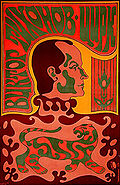Viktor Tikhonov
From Circopedia
Acrobat, Sharpshooter, Animal Trainer
By Dominique Jando
Viktor Petrovich Tikhonov was born on March 18, 1917 in Russia, in the midst of the so-called "February Revolution." His father, Pyotr, was a fairground entertainer who worked the balagans(Russian) Fairground booths or theaters. (the Russian fairground booths) with a sharpshooter act. Viktor made his debut as a child performer with his father, beginning as an acrobat and developing in time his own sharpshooting skills.
The nationalization of the Russian circuses in 1919 had prompted a large exodus of the foreign artists who had provided talent to their shows until then, and who were in turn followed by many Russian native performers (often of foreign descent) who left the newly born Soviet Union and went to work abroad. Eventually, Russian balagan(Russian) A fairground booth or theater. performers who showed some artistic merit were taken into the fold of the nascent state circus organization—until the government decided to establish the State College of Circus and Variety Arts in 1927 to provide the Soviet circus with a new generation of native performers.
An Outstanding Animal Trainer
So Viktor Tikhonov, the son of the balagan(Russian) A fairground booth or theater. performer, made his circus debut as a sharpshooter, soon joined by his wife, Liubov. (Since the term balagan(Russian) A fairground booth or theater. is derogatory in the Russian circus lingo, and is used to describe a lack of artistic form or professionalism—as in "it’s not circus, it’s balagan(Russian) A fairground booth or theater.!"—the natural elegance Viktor Tikhonov was to show in the ring seems all the more striking.) Creativity was the motto of the new Soviet circus, and Tikhonov warmed quickly to that idea. He added trained dogs to his act, who played various "characters" reflecting human emotions. Tikhonov proved in the process to be a very good animal trainer; hence he dedicated his career to animal acts, each one more original than the other.
His first "première" was the training of a group of yaks, which he mixed with German shepherds. This had never been seen before (in Russia or elsewhere), and Viktor Tikhonov made indeed a very strong impression in the Soviet circus. Then, he was the first trainer in Russia to present a bison in the ring. Beside his obvious talent as a trainer, what also made Tikhonov stand out was his balletic elegance in the ring, his physical grace, which matched the natural fluidity of his charges’ moves. His acts stressed indeed the image of a human performer evolving among wild animals, instead of the more traditional image of a trainer imposing upon them. The elegant costume he wore reinforced this image.
In 1976, he created an act that has become legendary; it mixed four European bisons, six Siberian tigers, two dogs (a boxer and a Pomeranian), and a cheetah. Later, the cheetah was trained to ride horses, which were added to the ensemble. It was quite an impressive combination of animals! Finally, in 1980, Viktor Tikhonov was made Artist Emeritus of the Russian Soviet Federative Socialist Republic; he had then reached the status of circus icon, and his career was coming to an end. Viktor Tikhonov passed away March 20, 1991—three days after Boris Yeltsin was elected president of the Russian Federation by referendum. The world in which Viktor Tikhonov had been able to thrive, the Soviet Union, had just collapsed.
See Also
- Video: Viktor Tikhonov, mixed wild animal act, at Moscow's "Circus on Tsvetnoi Boulevard" (1967)


